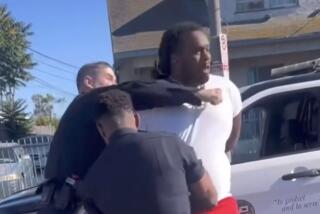Shoot-for-Head Policy of LAPD
- Share via
I agree with Antonio Rodriguez, in his article (Editorial Pages, March 13) about the new shooting policy of the Los Angeles Police Department, that public input is important. However, I can agree with neither the substance of nor the approach used in his contribution.
He concludes that the “use of deadly force cannot be reconciled with rational and humane social control, nor can it be restrained as long as police officers are not held accountable for their actions,” therefore the department’s “ ‘shoot for the head’ policy is a threat to the citizens . . . particularly in minority communities.” I am sure that he would also conclude that if there is to be public input, it should be as objective and accurate as possible.
Rodriguez admits in the first part of his article that “we do live in a violent society,” and that the new shooting policy is oriented toward suspects under the influence of the drug, PCP, and criminals wearing bulletproof vest. When we consider that it commonly requires at least four police officers to physically control one PCP suspect, and a criminal wearing a bulletproof vest is probably also armed and prepared to exact a high toll on those seeking his apprehension, I regret that Rodriguez waited until his final paragraph to introduce, and give such significance to, the concept of “rational and humane social control.”
It would require at least another article to give some meaning to such an all-encompassing concept and then explain its applicability to these specific situations. And it is important to remember that this shooting policy is oriented only toward situations when an officer’s life is endangered by an irrational and/or inhumane act, during which there are mere seconds to respond and not time for attempts at a rational dialogue.
Most of his article,, however, deals with the seeming lack of accountability by police officers, and makes liberal use of statements such as “internal police investigations of citizens’ complaints virtually guarantee that the findings will exonerate the officers,” while decrying the number of officers with “repeated citizens’ complaints against them” still on the force. To be valuable, public input should be accurate. Lack of substantiation by Rodriguez for statements of this type tend them more toward emotional generalizations than constructive input.
His one example, involving the Los Angeles Sheriff’s Department, is not even germane to his topic: LAPD’s shooting policy. But lest readers give undue weight to such generalization, I can assure them that LAPD does not hesitate to discipline any misconduct by its officers, for they are held accountable for everything they do during their workday.
Good relations between a police department and the community it serves require a willingness to communicate and understand the requirements of that relationship. The article by Rodriguez, with its reliance on generalizations of dubious accuracy, and social theory, without dealing with its applicability to specified situations, unfortunately makes little positive contribution toward that relationship.
STEPHEN M. KIRBY
Bellflower
Kirby is an officer with the Los Angeles Police Department, currently assigned to the Rampart Area.
More to Read
Sign up for Essential California
The most important California stories and recommendations in your inbox every morning.
You may occasionally receive promotional content from the Los Angeles Times.










